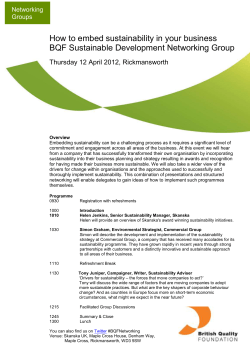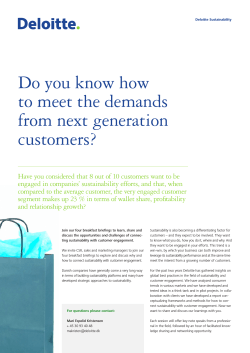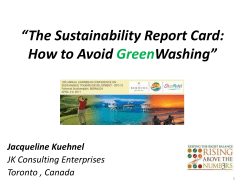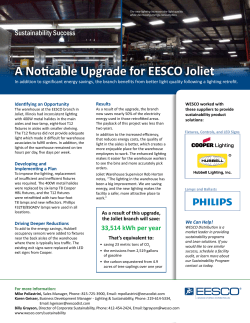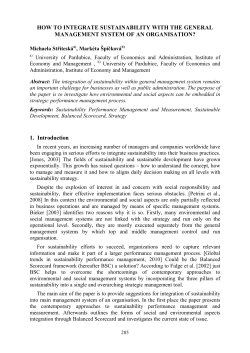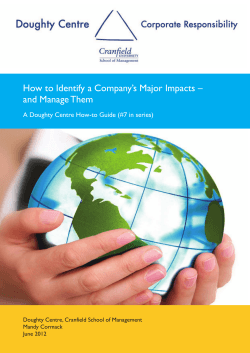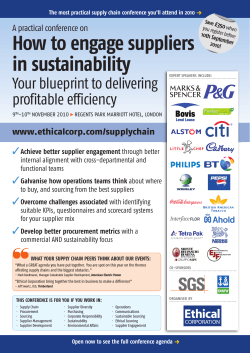
How to design a city in five easy steps: exploring... design decision-making
How to design a city in five easy steps: exploring VivaCity2020’s process and tools for urban design decision-making Prof. Rachel Cooper, Dr Christopher Boyko Lancaster University, UK Urban designers and planners are increasingly being asked to create and maintain communities that are more socially, economically and environmentally sustainable. Governmental and non-governmental organisations, such as the Department for Communities and Local Government (formerly Office of the Deputy Prime Minister), the Department of Environment, Food and Rural Affairs (formerly comprised of portfolios from the Department for Environment, Transport and the Regions) and the Commission for Architecture and the Built Environment, have published numerous reports and policy documents outlining the relationship between sustainability and urban design. ese reports and documents provide information and practical and aspirational guidance about the value of good design and the delivery of sustainable communities. To achieve the high expectations set out by Government and affiliated organisations, some decision-makers have been exploring how buildings and open spaces ‘come to be’, that is, how they develop from an idea to finished project and beyond. Knowing who is making decisions, what tools they are using to make decisions and whether or not they are considering sustainability can help those involved in the process of urban design to understand the complexities and tradeoffs surrounding when and how to incorporate sustainability into projects. is paper begins by discussing our current state of understanding about the urban design process as reviewed in the relevant literature. To do this, the fields of architecture, business, design, engineering, manufacturing and planning were surveyed to understand how processes are depicted, how they function and what similarities and differences exist between those processes and a plausible process for urban design. Research conducted as part of the VivaCity2020 project is presented next, highlighting case studies from three major UK cities–London, Manchester and Sheffield–and what we have learned from understanding the urban design process in-practice. e above processes are then compared, illustrating that sustainability and the tools used to make decisions are not often consistently considered by decision-makers in the process. To this end, a revised urban design process was created and validated by experts in design, planning, regeneration and sustainability that attempts to consider sustainability at each stage of the process. Along with the process is a suite of tools, developed during the VivaCity2020 project, that can be used when making decisions about a broad range of sustainability issues, including mixed-use, land-use diversity, environmental quality, housing choices, and public conveniences. A series of tools and the process, consisting of five stages, tasks and reviews, will be explained, all of which decision-makers can utilise and follow to create more sustainable urban design projects. Keywords: decision support, design process, tools, urban design, urban sustainability Introduction Conventional wisdom states that nothing worth doing comes easy. is is true for many things, including designing cities. A raft of guidance from Government and nongovernmental organisations tells us what we should do to create sustainable communities. Local authority planners attempt to enact this guidance while wrestling with the everyday realities of people and places in their area. Private sector decision-makers—architects, developers, landowners, investors—have their own bottom lines to worry about (e.g., making money, acquiring sites for development, designing great buildings and spaces). Residents want neighbourhoods that they like, feel attached to and are safe for their families. In short, the process for designing places is complex and fraught with endless tradeoffs and negotiations between the multitude of stakeholders over the short-, medium- and long-term. Does this mean, then, that cities cannot be designed in five easy steps? Probably not, but knowing more about this process—what are the stages and actions involved in designing cities, who makes decisions, what tools are used to make decisions and what issues are discussed—can help to shed light on the complexity of designing cities and, in particular, more sustainable urban design projects within these cities. e EPSRC SUE project, VivaCity2020, explored the process for urban design projects in the wider context of sustainability over 5 years, conducting an extensive literature review and case studies in London, Sheffield and Manchester. e result was a baseline process taken from the literature, three case study processes of urban design decision-making in-practice and a revised generic process that incorporated valuable information and lessons learned from the baseline and case study processes (i.e., sustainability and decision-making tools were not applied consistently throughout the lifetime of urban design projects). is paper briefly reviews the urban design literature and outlines the baseline process. Case studies are discussed next, followed by a presentation of the revised urban design process with tools that decision-makers can use to make more sustainable urban design decisions. Urban Design and the Urban Design Process Urban design is a multidimensional concept that highlights the transformative nature of urban environments (Barnett, 1982; Gosling, 2000; Rowley, 1994). Such transformation is perceived mostly in physical terms (e.g., re-positioning roads, pavements and open spaces to make a neighbourhood more legible); however, people have an important role to play in urban design. rough their evolving aesthetic, emotional, functional, psychological and social wants and needs, people act as drivers for urban design, shaping how urban environments look, feel and are used. e design of urban environments also has the capacity to shape how people behave, feel and think in such spaces. us, urban design is about transformation as well as reacting to, ongoing interaction with and being influenced by the urban environment. From this, a definition of urban design is presented: urban design refers to the dynamic art and process of designing, creating, making and managing spaces and places for people (adapted from CABE & DETR, 2000; Rowley, 1994; emphasis added). e notions of urban design as both a dynamic art and a process are key to this definition. ‘Dynamic art’ stresses creativity as well as context. While urban design may be comprised of a relatively generic set of principles, people, such as architects and artists, may reinterpret these principles into innovative ideas that best suit the context in which they are working (see Rogers & Power, 2000, for a description of context). Increasingly, the community is becoming more involved in shaping the urban design of an area, in line with the UK Government’s remit for creating more sustainable communities (CLG, 2006; ODPM, 2002, 2003, 2004, 2005a, 2005b, 2006). ‘Process’ stresses the following of a method, procedure or series of actions that lead to the accomplishment of a result (Atkin, Borgbrant, & Josephson, 2003; OED, 2005). is method, procedure or series of actions is often complex, iterative and non-linear (Rowley, 1994), involving many different people and issues throughout the lifetime of an urban design project. Illustrating a generic, conceptual guide adds value to the individual parts and people in the process; thus, the resulting whole becomes greater than the sum of its parts (Carmona & Tiesdell, 2007). A generic process for urban design allows the ‘dynamic art’ to be articulated. Such a process can demonstrate potential creativity in urban design projects by giving decisionmakers the opportunity to be innovative amidst a multitude of constraints (e.g., site, financial). A generic process also is capable of incorporating context-specific issues into the set of specific stages and actions that decision-makers can follow. A review of the relevant literature highlighted that a precise process for urban design did not exist. us, a generic process was created from an amalgamation of existing design processes to begin to understand the complexity of urban design decision-making. Inpractice urban design processes could then be compared to the generic process to understand whether the conceptual model fits with what occurs in the ‘real world’. From a consultation of design processes in architecture (RIBA, 1999), business (Smith & Jackson, 2000), manufacturing, construction, engineering (Austin et al., 2001; Cooper et al., 2005; Woodhead, 2000), non-governmental organisations (English Partnerships, 2000; Heritage Lottery Fund, 2000), planning (Bressi, 1995; Nelessen, 1994; Okubo, 2000; Roberts, 2003; Wates, 1996, 1998) and ‘urban design’ (Biddulph, 1997; Canadian Institute of Planners, 2000; Rowland, 1995; see also Macmillan et al., 2002), the following generic process was created with four stages and four transition stages: Stage 1: “Creating teams, appraising the situation and forming goals.” is is when decision-makers begin thinking about an urban design project. During this stage, teams are formed, the project site and its context are assessed through a variety of ways (e.g., site survey, valuation of surrounding sites), project objectives are written, stakeholders are identified of the project, funding is sought and timescales are drafted. Stage 2: “Designing and developing.” Here, decision-makers are designing different options for the project. is action will be based on a design brief developed by the team as well as an evaluation and testing of ideas in the brief and, ideally, stakeholder feedback. Stage 3: “Evaluating, selecting and creating a plan.” e urban design options are assessed in light of the objectives in Stage 1 and decision-makers will chose an option. is option will be evaluated further, stakeholders will be consulted on the option and a plan including timescale will be devised. Stage 4: “Implementing, monitoring and following up.” e decision-makers implement their selected option via the construction process. Once built, the urban design project will be monitored and a group (e.g., management company) will be set up to manage the project. In between the stage are transition stages—“Continuing to understand the context”, “Continuing to think about alternatives”, “Re-creating a plan” and “Continuing the process”—that act as “soft gates” for decision-makers to re-evaluate their past actions and plan for the next stage (Kagioglou et al., 1998). e transition stages also support the idea that the process is iterative, as decision-makers may use the transition stages to amend actions from a previous stage before moving on to the next stage. e next section highlights three case studies, undertaken for the VivaCity2020 project. e case studies represent ‘real world’ examples of urban design processes from different urban design projects in the United Kingdom. Urban Design Process Case Studies Urban design projects within London, Sheffield and Manchester were chosen because of their scale and type of development. A small- (i.e., urban block), medium- (i.e., city centre neighbourhood) and large-scale (i.e., area comprising seven neighbourhood boroughs) development was selected, each with different objectives: infill, repair and recovery and regeneration, respectively. e processes also covered different timescales because each project had a different starting and ending point. City/site Scale of development Type of Process timescale development Clerkenwell, London Urban block In9ill, mixed‐use, 10 years (Brewhouse Yard) contemporary and listed buildings Shef9ield city centre Neighbourhood/quarter Repair and recovery, 25 years (Devonshire Quarter) mixed‐use (leisure, of9ice, residential, retail) Manchester/Salford 7,200 hectares, seven Urban regeneration 3 years (Central Salford) boroughs Urban design processes were mapped for each project, based on the gathering of multiple sources of information (e.g. archival materials, interviews, questionnaires, observations) from a range of decision-makers and stakeholders (e.g., academics, architects, developers, government, residents). Each process told a story about urban design decisions and who made those decisions; tools used in decision-making; who the stakeholders were, and; what were the major issues involved in the urban development site, including sustainability. Case Study Findings Each of the processes was mapped using timescales to illustrate discrete stages and actions or decision points (see Figures 1, 2 and 3). Researchers chose to use timescales because this method of understanding decisions had been utilised in previous research (see Cooper et al., 2005). Moreover, timescales permitted researchers the ability to follow the progress on an urban design project, from its early stages to its completion and beyond or, as seen in the Manchester case study, up to its current day status. Knowing chronologically what happened enabled a story to be told and helped to better identify decision points as and when they occurred (i.e., decisions could be more easily identified —using the generic urban design process, which is based on an amalgamation of established decision-making processes, as a guide—through knowledge of what occurred immediately before, including who was involved in previous decision-making and what tools they used to make those decisions). In the London and Manchester case studies, the actions and stages related to some of the actions and stages in the generic urban design process (Boyko et al., 2005, 2006). In the Sheffield case study, the process took the form of five key decisions, rather than discrete stages and actions. Because several key decisionmakers contributed to the development of the neighbourhood, understanding how they contributed to the overall area was important in illustrating the process. With more time, process maps could have been developed for each of the five key decisions as stand-alone processes. Clerkenwell, London (Brewhouse Yard): e Process Period 1 1995 • 1995-97: Client buys site, brings in architects. Architects appraise site, identify requirements from Planning and develop objectives. Pre-design discussions begin. • 1998: Architects design for outline planning permission, consulting stakeholders, and communicate their objectives to Planning. They work on designs with Case Officers and submit applications. • 1998: RSL is approached by client to provide affordable housing. RSL seeks funding. • 1998: Planning evaluated applications using Site brief, design strategies and other policies. • 1998: Client granted planning permission. A new value is generated for the land and the client sells site. Period 2 Period 3 2000 • 1998: New client buys site, brings in international architects, informally consults Case Officer about site and forms objectives. • 1998: Leases Berry House to Internet company. • 2000: Dot-com bust. Client loses money on Berry House. • 2000: Client sells residential part of site to new client. 2005 • 2000: New client brings in residential architects. Architects appraise context via outline permission. • 2000: Office part of site sold to new client. • 2000: RSL receives funding for affordable housing. They help with residential design. • 2000: Office and residential is designed. Key stakeholders are consulted and Site is appraised. Planning applications are submitted. • 2001: Full planning permission granted. Construction begins. RSL buys affordable housing part of site. • 2003: Most of the construction is complete. Defects liability period starts on affordable housing. • 2003-present day: Site is monitored and managed by different groups Figure 1. e urban design process for the London case study. Source: VivaCity2020. Sheffield City Centre (Devonshire Quarter): e Process Devonshire Green kept as open space West One is designed & built The Forum opens 1980 1990 Inner-city housing grants fund living on Devonshire Street • 1981: Council keeps Devonshire Green an open space and creates an urban park on the land. • Mid-to-late 1980s: Council allows inner city housing grants to fund housing in Devonshire Quarter. • 1988: Broomhall Flats are demolished. • 1990: The Forum opens. It expands twice in the 13 years since opening. • 1991: Broomsprings, a mixedtenure development, is built on Broomhall Flats land. • 1993-2004: West One is designed and built. • 1998: The Devonshire Quarter Association is created. 2000 Devonshire Quarter Association is created • 2000: A skate park is created in Devonshire Green. • 2001: The Devonshire Quarter Action Plan is developed. • 2004: Sheffield’s Urban Design Compendium and City Centre Living Strategy are created. • 2004/2005: Council has plans to renovate Devonshire Green with help of Devonshire Quarter Association. Figure 2. e urban design process for the Sheffield case study. Source: VivaCity2020. Manchester/Salford (Central Salford): e Process Early vision and stakeholder formation 2002 Selection of team 2004 1st stage briefing & conceptual design • Early 2002: Chief Executive thinks about a unifying vision for Central Salford to improve quality of life. • Mid 2002: Chief Executive asks a ‘face’ and others to join him. • August 2003: A Steering Group is formed to help transform Central Salford. They believe a design competition is best way to articulate a vision. 2005 2nd stage briefing & conceptual design • January 2004: The first stage brief for the design competition is written. • 16 July 2004: Expressions of interest returned by competition consortia. • 27 July 2004: Short-listing of consortia. • 29 July 2004: Tenders are issued. • 12 November 2004: Interview and presentation by competition consortia to the judging panel. • 15 November 2004: Appointment of winning competition consortium. • Winter-Autumn 2005: Study to create vision and regeneration framework is conducted. Various stakeholders are consulted. Figure 3. e urban design process for the Manchester case study. Source: VivaCity2020. Looking across the three case studies, relevant findings surfaced about the urban design processes, sustainability and tools. Each of these issues will be discussed in turn. e Process All three case studies highlighted the lack of an explicit urban design process being followed (e.g., written down, visual, tabular). Rather, decision-makers employed an ad hoc process, particularly in London and Sheffield, shaped by past experiences, knowledge, policy, private sector needs and the public sector planning process. ese ad hoc processes were shared implicitly within individual organisations (e.g., architecture firm), but not necessarily between organisations (e.g., local authority and developer). In the Manchester case study, a process for forming an urban regeneration company (URC) was observed. e team involved with the URC used guidance from English Partnerships, additional guidance documents and past experiences from established URCs to help consider different strategies. e URC team was following a process (i.e., for establishing a quasi-governmental body to consider urban regeneration), albeit not a process for more sustainable urban design in the regeneration area. Tools Decision-makers employed a variety of tools in the three case studies. ese included general government guidance, interpersonal skills, personality traits, planning documents and temporal/structural issues. Rarely mentioned was computer-based support. is could be because the interviewees often had technical help to assist them when needed. Nonetheless, the increasing ubiquity of such tools indicates that they will continue to play a critical role in decision-making. In London, decision-making tools were a mix of both human- and policy and planningcentred. Public sector planners mentioned that the right team, comprised of good-quality planners to achieve a local authority’s goals, was fundamental. Team members also needed to have good brief-writing and design strategy skills, know suitable government policy, be conversant with the historical area and planning context and hold pre-planning application meetings to negotiate planning-related issues and develop a good, long-term working relationship with applicants. Private sector decision-makers said that holding internal design review meetings were key, particularly for architects who wanted constructive feedback from colleagues before showing client teams any designs. In Sheffield, the local authority mainly referenced government policies and programmes when making decisions. ey also read academic journals and trade magazines about various issues (e.g., city centre housing) and had an intimate knowledge of the economic climate in the city, which was helpful when making decisions about new development opportunities. Private sector decision-makers used their knowledge and prior experiences in Sheffield to find the best development opportunities. is often took the form of relying on “gut feelings,” rather than using common research studies to make decisions. Nonetheless, they always tried to have a good working relationship with public sector planners. In Manchester, many of the local authority’s decision-making tools were people- and characteristics-based. is is likely because the process was just beginning; thus, reflection was needed to think about leadership, the team, goals and value systems. Central Salford had a visionary leader who had strong conviction and fervour to take forth an urban regeneration vision. e leader also knew that he had to surround himself with the “right” team, so he first hired a media-savvy person who was passionate about Central Salford. Together, they employed a team with experience and knowledge in academia, brief writing, business, government, planning, regeneration, and the city, itself. ey all shared a similar value system (i.e., increasing quality of life). Sustainability e three case studies demonstrated that sustainability was explicitly considered in decision-making. However, it was considered by different decision-makers, at different times and at different levels of detail. Decision-makers Most of the decision-makers who made decisions about sustainability were in local authority planning departments. ey were responsible for examining the robustness of the planning applications within context. Such assessments included a range of fine- grained decisions about building details (e.g., the style of pointing used between bricks) and more strategic design decisions (e.g., the legibility of a site in a built-up borough), all of which impacted on the sustainability of the urban design projects. Private sector developers and architects made sustainability decisions, often in consultation with clients, landowners, financiers and insurance actors. e level of decision was mostly at the building-level (e.g., use of local building materials) and rarely encompassed sustainability decisions at the neighbourhood level and beyond. When the latter decisions were made, local authority often strongly guided decision-makers to do so. Economic feasibility was another reason for private sector decision-makers to consider sustainability. Timing of decisions Decision-makers made sustainable urban design decisions throughout the process. In particular, decisions were made during brief preparation (by local authorities), while designing and developing the urban design sites (by local authorities and the private sector) and when evaluating and selecting a design for planning approval (by local authorities) (see Figure 1). us, local authorities had more opportunities to consider sustainability at many stages of the process than did decision-makers in the private sector. Level of detail of decisions e three case studies demonstrated that the level of detail of decisions about sustainability depended on what was important in that area and who was making the decisions. In London, sustainability was written into local authority planning briefs, guidance and policy. Planning and design officers also wrote about sustainability in the reports they gave to their planning committee. Nonetheless, the officers said sustainability was not a concept that was fully enforced through the planning system at the time of the case study in the 1990s. e private sector architect interviewed repeated these claims, stating that, due to restrictions on funding, he could not create an environmentally sustainable design (e.g., green roofs, greywater recycling). In Sheffield, local sustainability policy was mostly absent in the early 1980s. Nonetheless, local authorities and the private sector emphasised dimensions of sustainability. For example, the decision by the local authority to keep a park as an open space, rather than develop on it, is rooted in environmental and social sustainability (i.e., parks provide an oasis in a dense, urban space; parks are amenities for neighbouring residents). Moreover, an entrepreneur’s decision to create a mixed-use space for new retail businesses and leisure activities stemmed from his wish to help local businesses and create “a happening” in the city (i.e., promoting economic and social sustainability). Other decisions, such as allowing inner city housing, forming a neighbourhood association and creating a mixeduse site of office, retail and residential, highlighted the importance of social and economic sustainability. In Manchester, sustainability was rarely mentioned in the earliest design and regeneration briefing documents for the international design competition. When it was cited, sustainability was found under regeneration, which mostly concerned economic growth. us, design competition teams did not know the full extent of the sustainability challenges in the deprived area. Moreover, during the judging of the design competition entries, sustainability took a back seat to value for money, how the entries looked, creativity, market awareness, compatibility with government and aspiration. e revised urban design process with decision-making tools Having analysed the case study processes and compared them with the generic process, the urban design process was revised to reflect two new insights: sustainability needs to be considered at every stage and a consistent set of tools will enable decision-makers to make the most appropriate choices for sustainability. e revised process contains five stages, as well as sustainability tasks, sustainability reviews, a legacy archive1 and a suite of tools that have emerged from the VivaCity2020 project for decision-makers to use (tools with an asterisk, ‘*’, may be more useful at particular scales and types of urban design projects, such as a Local Authority masterplan) (see Figure 5). 1 A legacy archive is a device used to store knowledge, information and recorded decisions from an urban design project. Decision‐makers can look at the information to help them make decisions on their current project and future projects. Figure 4. e revised urban design process. Source: VivaCity2020. Stage 0: “Need/ Opportunity Identification.” In Stage 0, an individual or team (e.g., local authority, land owner) identifies a need (e.g., more green space) or an opportunity (e.g., new family homes) for an urban design project. e identification of a potential location for the project as well as partnership opportunities also occurs here. It is important for the individual or team to consider economic, environmental and social sustainability factors at this early stage when making decisions about the project because critical issues and tradeoffs will already being to emerge. Stage 1, ‘Exploration.’ In Stage 1, a Development Team is formed to explore the urban design project from a variety of angles (e.g., architecture, context, finances, sustainability) and develop the project further. A Project Sustainability Group also is formed, consisting of people who will likely be involved through the lifetime of the project (e.g., construction agencies, developers, financiers/investors, local authority, residents). A Group leader will be appointed who has the appropriate skills for the position. It will be the leader’s responsibility to ensure that new expertise is added to the team when necessary. In some cases, the Group may be only one or two people, especially when the project is small or the need/opportunity from Stage 0 is still being investigated. eir main task is to guarantee that sustainability is considered throughout the process. Both sets of teams will take the outputs from Stage 0 and begin to formalise them into a Sustainability Agenda. It is essential that they understand the basic tenets of sustainability and work in concert to create a viable project and a Sustainability Agenda. Sustainability Tasks. Between Stage 0 and the first Sustainability Review (see below), the Project Sustainability Group—with the help of the Development Team in some circumstances—creates a Sustainability Agenda based on knowledge, experience, information and decisions recorded in the legacy archive. e Agenda contains a ranked list of sustainability issues that the Group sees as important and will carry through to Stages 2 (Design and Development) and 3 (Detailed Design) of the project. It sets out in writing how the teams understand the sustainability issues and issue rankings within the project. is Agenda should be re-assessed throughout the process to ensure that existing and new sustainability issues are considered and ranked accordingly. Sustainability Review. Before the Development Team begins designing and developing their ideas for the project, they must agree on the Sustainability Agenda with the Project Sustainability Group. Doing so gives both teams a chance to think about the sustainability issue rankings and to negotiate any tradeoffs on the issues. Tools to use between Stages 0 and 2: • Bibliographic review of mixed-use: organised by theme; includes books, web site, journals and conferences • Environmental quality case studies: explains innovative, qualitative and quantitative methods for capturing environmental quality in London, Manchester and Sheffield; discusses findings related to residents’ experiences within city centres and measured levels of greenhouse gases • Housing case studies: shows residential areas in three city centres—London (Clerkenwell), Manchester (Hulme) and Sheffield (Devonshire Quarter)—and the • • • • • • • various types of housing that have been built in the UK from the 1820s until the present day Liveability postal survey: based on the Government's “liveability agenda” to capture residential satisfaction in an area. It comprises 24 questions, divided into four themes: upkeep and management of public space and buildings, road traffic and transport-related issues, abandonment or non-residential use of domestic property and anti-social behaviour Night-time economy and crime case studies: explores the relevant literature in detail as well as the night-time economy and crime in London, Manchester and Sheffield Retail and crime case studies: explores the relevant literature in detail as well as retail and crime in London, Manchester and Sheffield Space Syntax analysis: shows the relationship between street layout and residential property value using Council Tax Bandings, locational variables, age, property size and ambient density; shows the value and formation of urban centres by exploring the Space Syntax theory of Centre Formation, comparing different high streets using graphical representation and statistical analysis *Toilet user personas: each persona is an ‘archetypal user’, created in collaboration with user groups in research about city centre toilet provision *Toilet user surveys: used to indicate people’s feelings about how provision meets, or fails to meet, the local community’s needs *Urban design and the creative arts: using data from the research, two artists created videos and prints, giving an alternative insight into sustainability and the urban experience of city users and residents Stage 2: “Design & Development.” In Stage 2, the actions of the Development Team correspond to stages/phases in construction management and architectural processes (e.g., Phase 4, Outline Conceptual Design, of the Process Protocol; Stage C of the RIBA Plan of Work). During this time, the Development Team begins designing their plan and considering design and development issues pertaining to sustainability. Sustainability Tasks. Between the first and second Sustainability Reviews, the two teams will generate Sustainability Advice as part of pre-planning application meetings. is task gives both teams an opportunity to give and seek advice about the sustainability of the project, and discuss sustainability tradeoffs. e tradeoff discussions may lead to a reranking of sustainability issues and a revised Sustainability Agenda, to be presented at the second Sustainability Review. Sustainability Review. e Project Sustainability Group will discuss tradeoffs and agree the re-ranking of the Sustainability Agenda with the Development Team. is allows both teams to be involved in the process and understand what sustainability issues are being considered in the project. e Project Sustainability Group also will examine and agree the Development Team’s preliminary designs. Tools to use between Stages 2 and 3: • Environmental quality case studies: see above • *Inclusive toilet hierarchy: identifies a hierarchy of provision in reference to awayfrom-home toilets; used to inform debates about the number and types of accessible toilet cubicles in any context • • • • • • • I-VALUL: a presentation, exploring residential burglary and street robbery and the value of personal and property security *Hulme case study: looks at the New Urbanist regeneration of Hulme, assessing whether the area has become a safer and more sustainable place to live Open Space Strategy: quantitative data for 30 housing schemes, including figure/ ground ratios of buildings and open spaces, the extent and type of non-residential uses, the public/private designation of open spaces, the local street hierarchy and the type, height, transparency and permeability of building façades and secondary boundaries (e.g., walls) Spatial data analysis: used to map economic, social and land-use diversity in the case study areas using GIS. Can be used with Space Syntax to identify street and pedestrian routes and on-street surveys to identify pedestrian movement (data available for London and Sheffield) *Toilet user personas: see above *Toilet user surveys: see above External tools: o Complex Built Environment Systems: a group interested in developing solutions to practical design, construction and managements problems o Cultural Planning Toolkit and Guidance o Design Against Crime: research, educational material and policy initiatives that aim to improve design’s effective in reducing crime o Inclusive Design for Getting Outdoors: research consortium focussed on ways to improve the design of outdoor environments to enhance older people’s quality of life o Live Work Network: an organisation devoted to providing information on live/work units o Space Syntax: an organisation providing an evidence-based approach to the planning and design of cities o Street Design Index: uses comprehensive mapping of neighbourhoods, communities and routes to enable decision-makers to consider a wide range of urban design issues (e.g., fear of crime, surveillance, amenities, signage) Stage 3: “Detailed Design.” In Stage 3, the actions of the Development Team correspond to stages/phases in construction management and architectural processes, (e.g., Phase 5, Full Conceptual Design, of the Process Protocol; Stages D and E of the RIBA Plan of Work). During the time, the Development Team progresses in more detail with their designs, demonstrating an exhaustive understanding of design issues pertaining to sustainability. Sustainability Tasks. Between the second and third Sustainability Reviews, the two teams will seek and provide Sustainability Performance Advice as part of pre-planning application meetings. is task will give both teams a chance to share information and knowledge about the proposed design and its potential performance in terms of sustainability ahead of the formal performance assessment at the third Sustainability Review. Sustainability Review. Once the Development Team has created a detailed design for the project and discussed sustainability performance with the Project Sustainability Group, the latter will evaluate the design against the Sustainability Agenda. Agreement between the detailed design and the Sustainability Agenda allows a “go-no go” decision for planning application submission. Disagreement suggests that the two teams will have to look at the Sustainability Advice given previously and will have negotiate further sustainability tradeoffs. Without this review, the Development Team may feel less certain about the robustness of their planning application with respect to the design and to sustainability. Tools to use between Stages 3 and 4: • Toilet design templates: building on recommendations from a wide range of British Standards, this guide is used to help design accessible and inclusive toilets Stage 4: “Detailed Design Implementation.” In Stage 4, the actions of the Development team correspond to stages/phases in construction management and architectural processes (e.g., Phase 6, Coordinated Design, Procurement and Full Financial Authority, of the Process Protocol; Stages F through L of the RIBA Plan of Work). Pending planning permission, the project will be constructed during this time. Sustainability Tasks. Once the project is built, both teams will consent to a Strategy for Sustainability Monitoring, which outlines management and maintenance plans for the site and the surrounding context in the short- and long-term. e strategy should incorporate a budget, timeline and a list of stakeholders who will manage and maintain the project over its lifetime. Sustainability Review. e two teams will review and assess the Strategy for Sustainability Monitoring, using the legacy archive and the Project Sustainability Reviews to guide assessment. is assessment offers a formal benchmark against which future urban design decisions can be compared and evaluated. Tools to use between Stages 3 and 4: • Urban design process case studies: discussed in this paper • Spatial data analysis: see above Conclusions is paper has demonstrated that, while cities cannot be designed in five easy steps, showing how urban design projects “come to be” and understanding where the gaps in knowledge lie certainly can help to illuminate a complex process and improve it. From the literature and the case studies, it was evident that sustainability and the tools used in decision-making were not made explicit nor considered consistently. e revised generic process takes these lessons and incorporates them into each stage, adding sustainability tasks and reviews for decision-makers to undertake. is gives stakeholders an opportunity to holistically evaluate sustainability within urban design projects and see where tradeoffs and negotiations lie. Having a consistent suite of decision-making tools to use at each stage of the process also helps in making more informed decisions about specific sustainability issues. e legacy archive can be utilised to capture the above information and store it for current and future use on urban design projects on that site and in the area. Finally, the generic process provides sufficient detail for sustainable decision-making without being too prescriptive, allowing for context-specific urban design that follows a loose series of actions. Perhaps it is not so difficult after all? References Atkin, B., Borgbrant, J., & Josephson, P.-E. (Eds.) (2003). Conclusions. In Construction Process Improvement (pp. 292-298). Oxford: Blackwell Science Ltd. Austin, S., Steele, J., Macmillan, S., Kirby, P., & Spence, R. (2001). Mapping the conceptual design activity of interdisciplinary teams. Design Studies, 22 (3), 211-232. Barnett, J. (1982). An introduction to urban design. New York: Harper & Row. Biddulph, M. (1997). An urban design process for large development sites. Town and Country Planning, 66, 202-204. Boyko, C. T., Cooper, R., & Davey, C. (2005). Sustainability and the urban design process. Engineering Sustainability, 158 (ES3), 119-125. Boyko, C. T., Cooper, R., Davey, C. L., & Wootton, A. B. (2006). Addressing sustainability early in the urban design process. Management Of Environmental Quality, 17 (6), 689-706. Bressi, T. (1995). e real thing? We’re getting there. Planning, 61 (7), 16-21. CABE & DETR (2000). By design. Urban design in the planning system: Towards better practice. London: omas Telford. Carmona, M., & Tiesdell, S. (Eds.) (2007). Introduction. Urban design reader (pp. 1). Oxford: Architectural Press. Canadian Institute of Planners. (2000). e urban design process. Retrieved 24 June 2004 from http://www.cip-icu.ca/English/aboutplan/ud_proce.htm CLG. (2006). Strong and prosperous communities- e local government White Paper. London: TSO. Cooper, R., Aouad, G., Lee, A., Wu, S., Fleming, A., & Kagioglou, M. (2005). Process Management in Design and Construction. Oxford: Blackwell. English Partnerships. (2000). Urban design compendium. London: English Partnerships. Gosling, D. (2002). e evolution of American urban design. New York: Wiley & Sons. Heritage Lottery Fund. (2000). Building projects: Your role in achieving quality and value. London: Heritage Lottery Fund. Kagioglou, M., Cooper, R., Aouad, G., Hinks, J., Sexton, M., & Sheath, D. M. (1998). A generic guide to the design and construction process protocol. Salford: University of Salford. Macmillan, S., Steele, J., Kirby, P., Spence, R., & Austin, S. (2002). Mapping the design process during the conceptual phase of building projects. Engineering, Construction and Architectural Management, 9 (3), 174-180. Nelessen, A. C. (1994). Visions for a new American dream: Process, principles, and an ordinance to plan and design small communities (2nd ed.). Chicago: Planners Press. ODPM. (2002). Sustainable communities: Delivering through planning. London: ODPM. ODPM. (2003). Sustainable communities: Building for the future. London: ODPM. ODPM. (2004). Diversity and planning: Research report on planning policies and practice. London: ODPM. ODPM. (2005a). Planning Policy Statement 1: Delivering sustainable development. London: ODPM. ODPM. (2005b). Sustainable communities: People, places and prosperity. London: ODPM. ODPM. (2006). e Office of the Deputy Prime Minister’s Sustainable Development Action Plan. Securing the future: Delivering UK sustainable development strategy. London: TSO. Okubo, D. (2000). e community visioning and strategic planning handbook. Denver, CO: National Civic League Press. Retrieved 20 July 2005 from http://www.ncl.org/ publications/online/VSPHandbook.pdf Oxford English Dictionary. (2005). Definition of the word ‘process’. Retrieved 8 March 2 0 0 5 f r o m h t t p : / / d i c t i o n a r y. o e d . c o m / c g i / e n t r y / 5 0 1 8 9 1 4 8 ? query_type=word&queryword=process&first=1&max_to_show=10&sort_type=al pha&result_place=4&search_id=mN9p-XRa38f-2385&hilite=50189148 RIBA. (1999). RIBA Plan of Work. London: RIBA. Roberts, M. B. (2003). Making the vision concrete: Implementation of downtown redevelopment plans created through a visioning process. Unpublished doctoral dissertation proposal, University of California, Irvine, Irvine, California. Rogers, R., & Power, A. (2000). Cities for a small country. London: Faber & Faber. Rowland, J. (October 1995). e urban design process. Urban Design Quarterly, 56. Retrieved 14 July 2004 from http://www.rudi.net/bookshelf/ej/udq/56/udp.cfm Rowley, A. (1994). Definitions of urban design: e nature and concerns of urban design. Planning Practice & Research, 9 (3), 179-198. Smith, J., & Jackson, N. (2000). Strategic needs analysis: Its role in brief development. Facilities, 18 (No 13/14), 502-512. Wates, N. (April 1996). A community process. Urban Design Quarterly, 58 Supplement. Retrieved 14 July 2004 from http://www.rudi.net/bookshelf/ej/udq/58conf/cp.cfm Wates, N. (July 1998). Process planning session. Urban Design Quarterly, 67 Special report: Involving Local Communities in Urban Design. Retrieved 14 July 2004 from http://www.rudi.net/bookshelf/ej/udq/67_report/method_10.cfm Woodhead, R. M. (2000). Investigation of the early stages of project formulation. Facilities, 18 (13/14), 524-534.
© Copyright 2025
